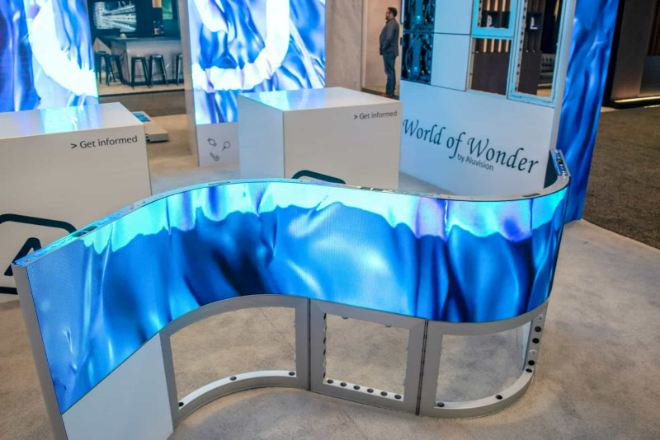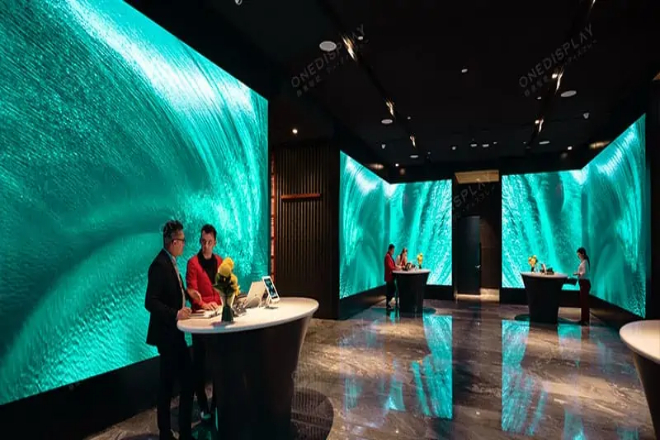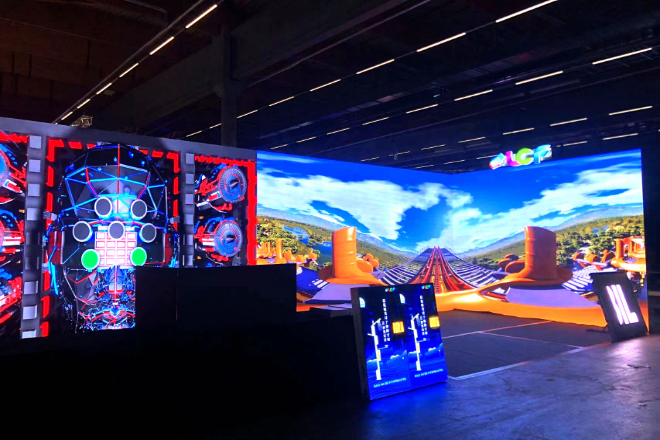Introduction

With the development of science and technology, LED display screens have become more and more important in people’s lives.
Among many application occasions, exhibitions are an important platform for displaying new products, new technologies, and new concepts, and the requirements for LED display screens are particularly special. So, what is the difference between the LED display screens used at exhibitions and other LED display screens?
1. What are the specific requirements for LED display screens at exhibitions?
1). High resolution and clarity
At exhibitions, it is crucial to display high-quality images and videos because this is directly related to the audience’s visual experience and display effect.
Therefore, LED display screens must have high resolution to ensure the fineness of the image and the accuracy of color. Small-pitch LED display screens perform well in this regard, with extremely small distances between pixels, which can present more delicate and realistic picture effects.
At exhibitions, small-pitch LED display screens are widely used to display high-definition pictures, video animations, product demonstrations, and other content.
Due to its high resolution and excellent color expression, it can attract the attention of the audience and improve the display effect.
2). Large size and splicing flexibility
Large-size display screens are often required at exhibitions to attract the attention of the audience and display more content. LED display screens achieve large-size display and flexible splicing through modular design.
At the exhibition, large-size display screens can display products or services more intuitively and bring shocking visual experiences to the audience.
LED display screens can be customized with display screens of different sizes according to exhibition needs to meet various display scenarios.
3). Interactivity and experience
At the exhibition, LED display screens are not only a display platform but also an interactive experience platform.
By introducing technologies such as touch screens, somatosensory interaction, and voice recognition, LED display screens can enhance the audience’s participation and experience.
LED display screens combined with touchscreen technology can achieve direct interaction between the audience and the display content. The audience can operate the display content, obtain more information, or participate in interactive games by touching the screen.
This interactive method enhances the audience’s sense of participation and improves the display effect.
2. What are the unique designs of LED display screens at the exhibition?

1). Customized shape and size
At the exhibition, LED display screens are not just as simple as squares; they can be “transformed” according to the layout and display needs of the exhibition hall! This customized design really greatly improves the display effect and opens the eyes of the audience.
1.1). The magic of customized design:
When you walk into an exhibition hall, you see not an ordinary rectangular screen but a curved screen that perfectly matches the shape of the exhibition hall, a curved screen that seems to be suspended in the air, or even a huge spherical screen.
Isn’t that a shocking feeling instantly bursting? This is the charm of customized design. Manufacturers will work with the organizers to design a practical and cool LED display screen based on the theme, content, and venue conditions of the exhibition.
1.2). Application examples of special shapes:
Curved screens and curved screens are particularly popular at exhibitions. They can create a surrounding visual experience, making the audience seem to be surrounded and immersed in the display content.
The spherical screen is even more unique. It can not only display a 360-degree panoramic picture but also allow the audience to see the complete picture from any angle. It is really super cool!
2). Environmental adaptability
At the exhibition, the LED display screen has to face various “tests,” such as strong sunlight, the flickering of indoor lights, and various “onlookers” from the audience. Therefore, LED display screens must have strong environmental adaptability to ensure the stability and consistency of the display effect.
2.1). Response to light changes:
Did you know? LED display screens have an “intelligent dimming system” that can automatically adjust the brightness according to changes in ambient light.
For example, when the sun is strong, the screen will automatically brighten to ensure that the picture is clear and visible, and when the indoor lights are dimmed, the screen will automatically dim to avoid glare.
In this way, no matter how the environment changes, the display effect can be maintained at its best.
2.2). The secret of color reproduction:
At exhibitions, color is very important. If the color is not accurate, the display content will be greatly discounted. Therefore, LED display screens must have excellent color reproduction capabilities.
There are actually many “black technologies” behind this, such as high-quality LED lamp beads, advanced circuit design, and color management systems. They work together to ensure that the color of the displayed content is exactly the same as the original image, allowing the audience to see the most realistic and vivid pictures.
Moreover, LED display screens must also have good heat dissipation performance, stability, and durability. After all, the exhibition has to work continuously for a long time. If the screen “strikes” or the picture is blurred, it will be a big disappointment.
Therefore, these unique design features are all to make the LED display screen perform at its best at the exhibition so that the audience can enjoy a visual feast!
3. Maintenance and management of LED display screens at exhibitions
1). Modular design and easy maintenance
At the exhibition, the maintenance and management of LED display screens are crucial, and modular design is the key to solving this problem. Modular design divides the LED display screen into multiple independent modules, and each module is responsible for a part of the content in the display screen. This design makes the disassembly and maintenance of the LED display screen extremely convenient.
1.1). Convenient disassembly and maintenance:
Imagine that if the LED display screen fails, the traditional design may need to remove the entire screen and then check the problems one by one, which is not only time-consuming and labor-intensive but may also affect the normal progress of the exhibition.
Modular design is different. Once a module has a problem, the staff can quickly locate and replace or repair only the module without disassembling the entire display screen. This greatly simplifies the maintenance process and reduces the difficulty and cost of maintenance.
1.2). Quick response to maintenance needs:
During the exhibition, the normal operation of the LED display is crucial. The modular design enables the exhibition hall to respond to maintenance needs more quickly and ensure the smooth progress of the exhibition.
If a module fails, the staff can immediately replace or repair it without affecting the normal operation of other modules, thus ensuring the continuity and integrity of the entire exhibition.
2). Remote control and content management
With the continuous advancement of technology, remote control, and content management have become important tools for the maintenance and management of LED displays at exhibitions.
2.1). Real-time update of display content:
The remote control system allows the exhibition hall to remotely access and control the LED display through the network. This means that no matter where the exhibition hall is located, the display content can be updated in real-time to ensure the timeliness and accuracy of the exhibition information.
For example, if the exhibition plan changes or some important information needs to be released urgently, the exhibition hall can immediately update the display content through the remote control system without having to go to the site in person.
2.2). Improve the exhibition effect and information transmission efficiency:
The content management system also plays an important role in improving the exhibition effect and information transmission efficiency.
Through the content management system, the exhibition hall can pre-set content playback plans for different time periods to ensure that specific content is displayed at a specific time. This can not only improve the viewing and interactivity of the exhibition but also convey information to the audience more effectively.
In addition, the content management system can also classify, label, and search the display content, which is convenient for the exhibition hall to manage and find the required content and improve work efficiency.
4. Characteristics and applications of LED display screens on other occasions

1). Commercial advertising and outdoor LED display screens
In the field of commercial advertising, LED display screens have become an ideal choice for outdoor advertising with their unique advantages and characteristics.
1.1). Application characteristics:
- High brightness and visibility:
In outdoor environments, LED display screens need to have extremely high brightness to cope with strong sunlight. High-brightness LED display screens can maintain clear pictures even during the day to ensure the effective communication of advertising information.
- Waterproof and dustproof design:
Outdoor display screens need to adapt to various harsh weather conditions, so they usually adopt a waterproof and dustproof design to ensure that they can still work normally in harsh environments such as rainy days and sand and dust.
- Remote control and real-time update:
Commercial advertising needs to respond quickly to market changes. The remote control system of LED display screens allows advertisers to change and publish advertising content at any time, improving the flexibility and efficiency of advertising.
1.2). Compared with the LED display screen at the exhibition:
- Brightness difference:
The brightness of outdoor display screens is usually higher than that of display screens at exhibitions to meet the visibility requirements in outdoor strong-light environments.
- Viewing angle difference:
Outdoor display screens require a wider viewing angle to ensure that a clear picture can be obtained from all angles. Although the display screens at exhibitions also focus on viewing angles, they may focus more on the viewing effect of audiences in specific areas.
- Content difference:
The advertising content of outdoor display screens is usually more concise and clear, focusing on attracting the attention of passers-by and vehicles. The display screens at exhibitions may display more diversified content, such as product demonstrations, interactive experiences, etc.
2). Indoor conference and monitoring center display screens
LED display screens also play an important role in occasions such as indoor conferences and monitoring centers, but their requirements are different from those of display screens at exhibitions.
2.1). Specific requirements of indoor conferences for LED display screens:
- High definition and color accuracy:
Indoor conferences need to display high-quality images and videos, so LED display screens need to have high resolution and high color accuracy.
- Seamless splicing and consistency:
In order to meet the needs of large conference rooms, LED display screens usually need to be seamlessly spliced to ensure the integrity and consistency of the entire picture.
- Remote real-time communication function:
With the popularity of video conferencing and remote collaboration, LED display screens also need to support remote real-time communication and collaborative office functions.
2.2). Specific requirements of monitoring centers for LED display screens:
- High reliability and stability:
The monitoring center needs to run 24 hours a day, so the LED display screen must have high reliability and stability to ensure the continuity and accuracy of the monitoring screen.
- Multi-signal source support:
The monitoring center may need to access multiple signal sources at the same time, such as cameras, computers, networks, etc., and the LED display screen needs to support multi-signal source input and switching.
- Easy to operate and manage:
The operators of the monitoring center need to easily control and manage the display screen, so the LED display screen needs to be equipped with intuitive and easy-to-use control software and operation interface.
2.3). Functional differences with LED display screens at exhibitions:
- Interactivity:
LED display screens at exhibitions usually focus on interactive experiences with the audience, such as touch screens, somatosensory interaction, and other functions. The display screens of indoor conferences and monitoring centers focus more on the display and transmission of information and are relatively less interactive.
- Content display form:
The display screens at exhibitions may display more diversified content forms, such as dynamic images, videos, audio, etc. The display screens in indoor conferences and monitoring centers focus more on the clear display of static images, text, charts, and other content.
- Usage scenarios:
The display screens at exhibitions are relatively short-term and concentrated, while the display screens in indoor conferences and monitoring centers need to run stably for a long time and have higher requirements for reliability and stability.
In summary, LED display screens show diverse characteristics and application requirements on different occasions.
Whether it is commercial advertising, outdoor display, indoor conference, or monitoring center, LED display screens provide efficient and convenient information display and delivery solutions for all walks of life with their unique advantages and characteristics.
Conclusion
In summary, the LED display screens used in exhibitions are significantly different from other LED display screens in many aspects. The LED display screens at exhibitions meet the specific needs of the special occasion of exhibitions with their high resolution, large size, splicing flexibility, interactivity, and experience.
In contrast, although the LED display screens on other occasions also have their own characteristics, they are obviously not comparable to the LED display screens used in exhibitions in terms of meeting the needs of the specific scene of exhibitions.
Finally, if you want to know more about LED display screens, please get in touch with us.
